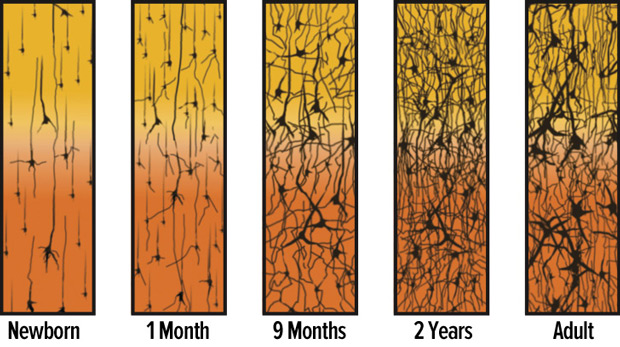Brain Science
Experiences Build Brain Architecture
Brain Architecture Supports Lifelong Learning, Behavior, and Health
Early experiences shape brain architecture.
Simple skills come first; more complex skills build on top of them.
A strong foundation in the early years improves the odds for positive outcomes and a weak foundation increases the odds of problems later in life.
Synapse Density Over Time
Source: Corel, JL. The postnatal development of the human cerebral cortex. Cambridge, MA: Harvard University Press; 1975.
During the first few years of life, 700 new synapses (neural connections) are formed every second.
Connections that are not used are pruned away, like cutting back an overgrown bush.
Early experiences determine which circuits are reinforced through frequent use and which are pruned through lack of use. Some people refer to this as “use it or lose it.”
But this process is a double-edged sword.
On the one hand, positive, healthy, growth-promoting experiences help to develop brains that are efficient and capable of any challenge.
But young children who experience abusive or profound neglect, for example, may increase the neural connections dedicated to fear and anger, and prune those dedicated to reasoning, learning, and memory.
These changes are then built into the architecture of their developing brains. Ensuring that all children have the right kinds of experiences can ensure that the neural connections that are growing – 700 every second – are the ones they need to thrive.
Serve & Return Interaction Shapes Brain Circuitry
Serve & Return Builds Brains and Skills
Ongoing, reliable interaction with trusted adults is essential for the development of healthy brain circuits.
Systems that support the quality of relationships in early care settings, communities, and homes help build brain architecture.
Barriers to Educational Achievement Emerge at a Very Young Age
Source: Hart & Risley (1995), Center on the Developing Child, Harvard University
Differences in development appear very early — in this instance, differences in vocabulary growth between children in low socio-economic households and high socio-economic households begin to appear as early as 18 months.
As the children grow toward school age, and enter school, the differences only get larger in the absence of intervention.
The key differences in these households were both the number and quality of the language children heard, from birth on. In low SES households — where there’s the stress of putting food on the table and working multiple jobs, where there’s lower education levels — children hear far fewer words, and the context does not invite interaction.
Early childhood programs that expose children to language-rich environments and engaging caregivers are especially important for these kids.
Toxic Stress Derails Healthy Development
Relationships Buffer Toxic Stress
Learning how to cope with moderate, short-lived stress can build a healthy stress response system.
Toxic stress—when the body’s stress response system is activated excessively—can weaken brain architecture.
Without caring adults to buffer children, toxic stress can have long-term consequences for learning, behavior, and both physical and mental health.
Significant Adversity Impairs Development in the First Three Years
Source: Barth, et al. (2008). Center on the Developing Child, Harvard University
The cumulative effects of adversity can pile up to derail the process of healthy development and dramatically increase the odds of developmental delays. This study followed children ages birth to 36 months who had been maltreated and found that the more risk factors they experienced, the greater their chance of experiencing problems in cognitive, social, emotional, and physical development.
Quality Early Care and Education Pays Off:
Cost/Benefit Analyses Show Positive Returns
Karoly et al. (2005), Heckman et al. (2009)
And in each case, the majority of those returns are to society — not to the individual. So while the individuals who participate do have better jobs, better education, and better lives, in terms of dollars returned from the investment, it’s society that is the big winner, primarily through savings in crime and justice, health care, and educational remediation costs.
Several rigorous longitudinal studies have looked at long-term outcomes of participants in early childhood programs and their benefits to the individuals and to society.
Perry Preschool's returns consist of increased earnings for individuals and, to the public, savings in welfare, special ed, and the costs of crime, as well as increased income tax revenues.
All have shown clearly that there IS a big return on investment — ranging from $3 to more than $9 for every dollar invested in the program.
The three shown here represent different kinds of interventions, populations, and goals, yet all of them yielded significant return on investment.
Keys to Health Development
A balanced approach to emotional, social, cognitive, and language development, starting in the earliest years of life.
Supportive relationships and positive learning experiences that begin with parents but are strengthened by others outside the home.
Highly specialized interventions as early as possible for children and families experiencing significant adversity.







